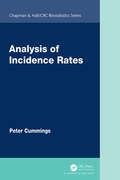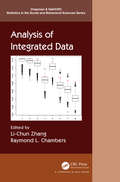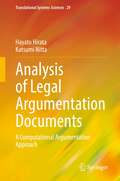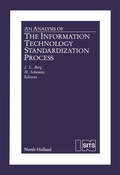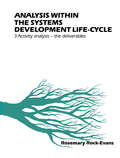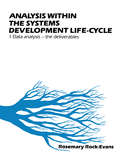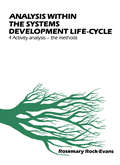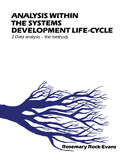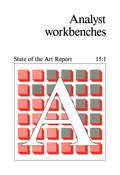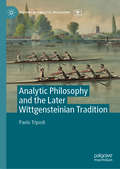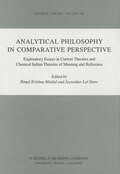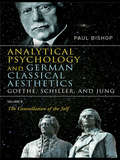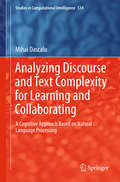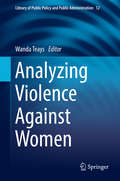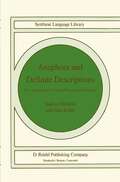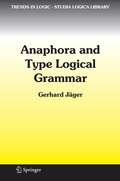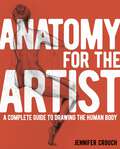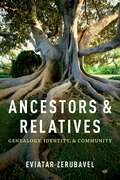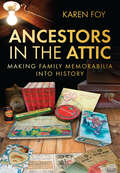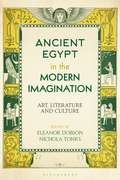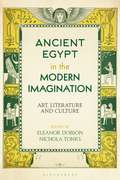- Table View
- List View
Analysis of Incidence Rates (Chapman & Hall/CRC Biostatistics Series)
by Peter CummingsIncidence rates are counts divided by person-time; mortality rates are a well-known example. Analysis of Incidence Rates offers a detailed discussion of the practical aspects of analyzing incidence rates. Important pitfalls and areas of controversy are discussed. The text is aimed at graduate students, researchers, and analysts in the disciplines of epidemiology, biostatistics, social sciences, economics, and psychology. Features: Compares and contrasts incidence rates with risks, odds, and hazards. Shows stratified methods, including standardization, inverse-variance weighting, and Mantel-Haenszel methods Describes Poisson regression methods for adjusted rate ratios and rate differences. Examines linear regression for rate differences with an emphasis on common problems. Gives methods for correcting confidence intervals. Illustrates problems related to collapsibility. Explores extensions of count models for rates, including negative binomial regression, methods for clustered data, and the analysis of longitudinal data. Also, reviews controversies and limitations. Presents matched cohort methods in detail. Gives marginal methods for converting adjusted rate ratios to rate differences, and vice versa. Demonstrates instrumental variable methods. Compares Poisson regression with the Cox proportional hazards model. Also, introduces Royston-Parmar models. All data and analyses are in online Stata files which readers can download. Peter Cummings is Professor Emeritus, Department of Epidemiology, School of Public Health, University of Washington, Seattle WA. His research was primarily in the field of injuries. He used matched cohort methods to estimate how the use of seat belts and presence of airbags were related to death in a traffic crash. He is author or co-author of over 100 peer-reviewed articles.
Analysis of Incidence Rates (Chapman & Hall/CRC Biostatistics Series)
by Peter CummingsIncidence rates are counts divided by person-time; mortality rates are a well-known example. Analysis of Incidence Rates offers a detailed discussion of the practical aspects of analyzing incidence rates. Important pitfalls and areas of controversy are discussed. The text is aimed at graduate students, researchers, and analysts in the disciplines of epidemiology, biostatistics, social sciences, economics, and psychology. Features: Compares and contrasts incidence rates with risks, odds, and hazards. Shows stratified methods, including standardization, inverse-variance weighting, and Mantel-Haenszel methods Describes Poisson regression methods for adjusted rate ratios and rate differences. Examines linear regression for rate differences with an emphasis on common problems. Gives methods for correcting confidence intervals. Illustrates problems related to collapsibility. Explores extensions of count models for rates, including negative binomial regression, methods for clustered data, and the analysis of longitudinal data. Also, reviews controversies and limitations. Presents matched cohort methods in detail. Gives marginal methods for converting adjusted rate ratios to rate differences, and vice versa. Demonstrates instrumental variable methods. Compares Poisson regression with the Cox proportional hazards model. Also, introduces Royston-Parmar models. All data and analyses are in online Stata files which readers can download. Peter Cummings is Professor Emeritus, Department of Epidemiology, School of Public Health, University of Washington, Seattle WA. His research was primarily in the field of injuries. He used matched cohort methods to estimate how the use of seat belts and presence of airbags were related to death in a traffic crash. He is author or co-author of over 100 peer-reviewed articles.
Analysis of Integrated Data (Chapman & Hall/CRC Statistics in the Social and Behavioral Sciences)
by Li-Chun Zhang and Raymond L. ChambersThe advent of "Big Data" has brought with it a rapid diversification of data sources, requiring analysis that accounts for the fact that these data have often been generated and recorded for different reasons. Data integration involves combining data residing in different sources to enable statistical inference, or to generate new statistical data for purposes that cannot be served by each source on its own. This can yield significant gains for scientific as well as commercial investigations. However, valid analysis of such data should allow for the additional uncertainty due to entity ambiguity, whenever it is not possible to state with certainty that the integrated source is the target population of interest. Analysis of Integrated Data aims to provide a solid theoretical basis for this statistical analysis in three generic settings of entity ambiguity: statistical analysis of linked datasets that may contain linkage errors; datasets created by a data fusion process, where joint statistical information is simulated using the information in marginal data from non-overlapping sources; and estimation of target population size when target units are either partially or erroneously covered in each source. Covers a range of topics under an overarching perspective of data integration. Focuses on statistical uncertainty and inference issues arising from entity ambiguity. Features state of the art methods for analysis of integrated data. Identifies the important themes that will define future research and teaching in the statistical analysis of integrated data. Analysis of Integrated Data is aimed primarily at researchers and methodologists interested in statistical methods for data from multiple sources, with a focus on data analysts in the social sciences, and in the public and private sectors.
Analysis of Integrated Data (Chapman & Hall/CRC Statistics in the Social and Behavioral Sciences)
by Li-Chun Zhang Raymond L. ChambersThe advent of "Big Data" has brought with it a rapid diversification of data sources, requiring analysis that accounts for the fact that these data have often been generated and recorded for different reasons. Data integration involves combining data residing in different sources to enable statistical inference, or to generate new statistical data for purposes that cannot be served by each source on its own. This can yield significant gains for scientific as well as commercial investigations. However, valid analysis of such data should allow for the additional uncertainty due to entity ambiguity, whenever it is not possible to state with certainty that the integrated source is the target population of interest. Analysis of Integrated Data aims to provide a solid theoretical basis for this statistical analysis in three generic settings of entity ambiguity: statistical analysis of linked datasets that may contain linkage errors; datasets created by a data fusion process, where joint statistical information is simulated using the information in marginal data from non-overlapping sources; and estimation of target population size when target units are either partially or erroneously covered in each source. Covers a range of topics under an overarching perspective of data integration. Focuses on statistical uncertainty and inference issues arising from entity ambiguity. Features state of the art methods for analysis of integrated data. Identifies the important themes that will define future research and teaching in the statistical analysis of integrated data. Analysis of Integrated Data is aimed primarily at researchers and methodologists interested in statistical methods for data from multiple sources, with a focus on data analysts in the social sciences, and in the public and private sectors.
Analysis of Legal Argumentation Documents: A Computational Argumentation Approach (Translational Systems Sciences #29)
by Hayato Hirata Katsumi NittaThis book introduces methods to analyze legal documents such as negotiation records and legal precedents, using computational argumentation theory.First, a method to automatically evaluate argumentation skills from the records of argumentation exercises is proposed. In law school, argumentation exercises are often conducted and many records of them are produced. From each utterance in the record, a pattern of “speech act +factor” is extracted, and argumentation skills are evaluated from the sequences of the patterns, using a scoring prediction model constructed by multiple regression analyses between the appearance pattern and the scoring results. The usefulness of this method is shown by applying it to the example case “the garbage house problem”. Second, a method of extracting factors (elements that characterize precedents and cases) and legal topoi from individual precedents and using them as the expression of precedents to analyze how the pattern of factors and legal topoi appearing in a group of precedents affects the judgment (plaintiff wins/defendant wins) is proposed. This method has been applied to a group of tax cases. Third, the logical structure of 70 labor cases is described in detail by using factors and a bipolar argumentation framework (BAF) and an (extended argumentation framework (EAF) together. BAF describes the logical structure between plaintiff and defendant, and EAF describes the decision of the judge. Incorporating the legal topoi into the EAF of computational argumentation theory, the strength of the analysis of precedents by combined use of factored BAF and EAF, not only which argument the judge adopted could be specified. It was also possible to determine what kind of value judgment was made and to verify the logic. The analysis methods in this book demonstrate the application of logic-based AI methods to the legal domain, and they contribute to the education and training of law school students in logical ways of argumentation.
An Analysis of the Information Technology Standardization Process
by J. L. Berg H. SchumnyA number of important issues form the basis of this book: How can the Information Technology (IT) standardization process, leading to unified products which are needed on the market, be made more efficient? Which current IT standards are of high quality, what factors have led to that high quality, and can those factors be re-created for other IT standards? What improvements to the quality of IT standards are needed? Which organizations should be involved? What permanent changes in the IT standardization scene are necessary? At what point in the evolution of a technology is it appropriate to produce standards? Is strategic planning feasible in the current standardization approach? Diverse disciplines contributed to the findings in this book: computer scientists, standardization leaders and professionals, users and vendors, economists, auditors, software implementors, and communication specialists.
Analysis within the Systems Development Life-Cycle: Book 3 Activity Analysis — The Deliverables
by Rosemary Rock-EvansAnalysis within the Systems Development Life-Cycle, Book 3: Activity Analysis — The Deliverables provides a comprehensive coverage of the deliverables of activity analysis. The book also details purpose of each deliverable in the context of the next tasks in the systems development cycle (SDC). The text first covers the concept of deliverables and the benefits of making deliverables visible. In the second chapter, the book introduces the main concepts and diagrammatic techniques of activity analysis. The third chapter deals with the important classes or categories of concept, while the fourth chapter talks about the deliverables of activity analysis. The book will be of great use to individuals involved in the design and management of complex development projects, such as systems engineers.
Analysis within the Systems Development Life-Cycle: Data Analysis — The Deliverables
by Rosemary Rock-EvansAnalysis within the Systems Development Life-Cycle: Book 1, Data Analysis—The Deliverables provides a comprehensive treatment of data analysis within the systems development life-cycle and all the deliverables that need to be collected in analysis. The purpose of deliverables is explained and a number of alternative ways of collecting them are discussed. This book is comprised of five chapters and begins with an overview of what ""analysis"" actually means, with particular reference to tasks such as hardware planning and software evaluation and where they fit into the overall cycle. The next chapter introduces the main concepts that will be used throughout the rest of the book, along with the main diagrammatic techniques that will be used to represent the deliverables. The discussion then turns to important categories of concept; what facts to collect about entity types; what facts to collect about attribute types; and the deliverables of the data design part of the systems development cycle. The final chapter summarizes all the deliverables and puts them into the context of the systems development cycle by describing the ""systems engine""—the ""meta-model"" of the systems development life-cycle. This monograph will be of interest to systems analysts and designers.
Analysis within the Systems Development Life-Cycle: Book 4 Activity Analysis—The Methods
by Rosemary Rock-EvansAnalysis within the Systems Development Life-Cycle: Book 4, Activity Analysis—The Methods describes the techniques and concepts for carrying out activity analysis within the systems development life-cycle. Reference is made to the deliverables of data analysis and more than one method of analysis, each a viable alternative to the other, are discussed. The ""bottom-up"" and ""top-down"" methods are highlighted. Comprised of seven chapters, this book illustrates how dependent data and activities are on each other. This point is especially brought home when the task of inventing new business activities is discussed, and the data model is changed with completely new entity types—the invention of the user and analyst being added—and ""old"" entity types being removed when the activities of the business are changed. The relevance of PROLOG, LISP, knowledge bases, and expert systems is considered, and these areas of interest are brought together into the fold of ""conventional"" systems development. Finally, this text shows how the ""rules"" of the knowledge base and the ""deduction"" clauses are directly related to the activity concepts. This monograph will be a valuable resource for systems analysts and designers and those who are involved in expert systems.
Analysis Within the Systems Development Life-Cycle: Book 2 Data Analysis — The Methods
by Rosemary Rock-EvansAnalysis within the Systems Development Life-Cycle: Book 2, Data Analysis—The Methods describes the methods for carrying out data analysis within the systems development life-cycle and demonstrates how the results of fact gathering can be used to produce and verify the analysis deliverables. A number of alternative methods of analysis other than normalization are suggested. Comprised of seven chapters, this book shows the tasks to be carried out in the logical order of progression—preparation, collection, analysis of the existing system (which comprises the tasks of synthesis, verification, and approval)—and in each case how the input from the previous task is converted to the output for the next task until the final output—the verified approved deliverables—is obtained. The first chapter puts analysis into its place in the Systems Development Cycle (SDC) and explains what analysis really means. The next chapters cover, in logical sequence of dependency, the actual tasks of data analysis. The advantages and disadvantages of each method are described in the context of the life-cycle as a whole and in terms of the reliability of raw input, time problems, and so on. Each of the data models obtained using the different methods can be combined and subsequently refined using a number of step-by-step checks. The final chapter shows how the meta-model can be expanded by considering the intermediate outputs of the tasks of data analysis. This text will be of interest to systems analysts and designers and those who are involved in expert systems.
Analyst Workbenches: State of The Art Report
by R. Rock-EvansAnalyst Workbenches examines various aspects of analyst workbenches and the tasks and data that they should support. The major advances and state of the art in analyst workbenches are discussed. A comprehensive list of the available analyst workbenches, both the experimental and the commercial products, is provided. Comprised of three parts, this book begins by describing International Computers Ltd's approach to automating analysis and design. It then explains what business analysis really means, outlines the principal features of analyst workbenches, and considers the ways in which they can solve the problems. The following chapters focus on how the analyst can deal with performance issues and lay proper foundations for the later, more detailed, work of the designer; the use of artificial intelligence techniques in workbenches; and strategic information systems planning technology. Integrated Project Support Environments (IPSEs) and the workbench-related phenomenon of mapping are also discussed. The final chapter evaluates future prospects for workbench products. This monograph will be a valuable resource for systems analysts and designers.
Analytic Philosophy and the Later Wittgensteinian Tradition (History of Analytic Philosophy)
by Paolo TripodiThis book aims to explain the decline of the later Wittgensteinian tradition in analytic philosophy during the second half of the twentieth century. Throughout the 1950s, Oxford was the center of analytic philosophy and Wittgenstein – the later Wittgenstein – the most influential contemporary thinker within that philosophical tradition. Wittgenstein's methods and ideas were widely accepted, with everything seeming to point to the Wittgensteinian paradigm having a similar impact on the philosophical scenes of all English speaking countries. However, this was not to be the case. By the 1980s, albeit still important, Wittgenstein was considered as a somewhat marginal thinker. What occurred within the history of analytic philosophy to produce such a decline? This book expertly traces the early reception of Wittgenstein in the United States, the shift in the humanities to a tradition rooted in the natural sciences, and the economic crisis of the mid-1970s, to reveal the factors that contributed to the eventual hostility towards the later Wittgensteinian tradition.
Analytical Philosophy in Comparative Perspective: Exploratory Essays in Current Theories and Classical Indian Theories of Meaning and Reference (Synthese Library #178)
by Bimal K. Matilal Jaysankar Lal ShawWe are grateful to the authors who wrote papers specially for this volume and kindly gave their permission for printing them together. None of these papers appeared anywhere before. Our special thanks are due to the first six authors who kindly responded to our request and agreed to join this new venture which we are calling 'comparative perspective' in ana lytical philosophy. In the introductory essay certain salient points from each paper have been noted only to show how 'com parative perspective' may add to, and be integrated with, mod ern philosophical discussion in the analytic tradition. Need less to say, any mistake, possible mis-attribution or misrepresentation of the views of the original authors of the papers (appearing in the said introductory essay) is entirely the responsibility of the author of that essay. The author apologizes if there has been such unintentional misrepresenta tion and insists that the readers should depend upon the orig inal papers themselves for their own understanding. For typo graphical problems it has not always been possible to use the symbols originally used by the authors, but care has been taken to use the proper substitute for each of them. Bimal K. Matilal ANALYTICAL PHILOSOPHY IN COMPARATIVE PERSPECTIVE: AN INTRODUCTION 1. The aim of this volume is to extend the horizon of philosophi cal analysis as it is practiced today.
Analytical Psychology and German Classical Aesthetics: The Constellation of the Self
by Paul BishopThe second volume of Analytical Psychology and German Classical Aesthetics builds on the previous volume to show how German classicism, specifically the classical aesthetics associated with Goethe and Schiller known as Weimar classicism, was a major influence on psychoanalysis and analytical psychology alike. This volume examines such significant parallels between analytical psychology and Weimar classicism as the methodological similarities between Goethe’s morphological and Jung’s archetypal approaches, which both seek to use synthesis as well as analysis in their attempt to understand the world. It also focuses on the project of the construction of the self, which, it is argued, is not only a personal but also a cultural activity. This book, like its previous volume, aims to clarify the intellectual continuity between Weimar classicism and analytical psychology. It will be of interest to both students and scholars in the fields of analytical psychology, comparative literature, and the history of ideas.
Analytical Psychology and German Classical Aesthetics: The Constellation of the Self
by Paul BishopThe second volume of Analytical Psychology and German Classical Aesthetics builds on the previous volume to show how German classicism, specifically the classical aesthetics associated with Goethe and Schiller known as Weimar classicism, was a major influence on psychoanalysis and analytical psychology alike. This volume examines such significant parallels between analytical psychology and Weimar classicism as the methodological similarities between Goethe’s morphological and Jung’s archetypal approaches, which both seek to use synthesis as well as analysis in their attempt to understand the world. It also focuses on the project of the construction of the self, which, it is argued, is not only a personal but also a cultural activity. This book, like its previous volume, aims to clarify the intellectual continuity between Weimar classicism and analytical psychology. It will be of interest to both students and scholars in the fields of analytical psychology, comparative literature, and the history of ideas.
Analyzing Discourse and Text Complexity for Learning and Collaborating: A Cognitive Approach Based on Natural Language Processing (Studies in Computational Intelligence #534)
by Mihai DascăluWith the advent and increasing popularity of Computer Supported Collaborative Learning (CSCL) and e-learning technologies, the need of automatic assessment and of teacher/tutor support for the two tightly intertwined activities of comprehension of reading materials and of collaboration among peers has grown significantly. In this context, a polyphonic model of discourse derived from Bakhtin’s work as a paradigm is used for analyzing both general texts and CSCL conversations in a unique framework focused on different facets of textual cohesion.As specificity of our analysis, the individual learning perspective is focused on the identification of reading strategies and on providing a multi-dimensional textual complexity model, whereas the collaborative learning dimension is centered on the evaluation of participants’ involvement, as well as on collaboration assessment.Our approach based on advanced Natural Language Processing techniques provides a qualitative estimation of the learning process and enhances understanding as a “mediator of learning” by providing automated feedback to both learners and teachers or tutors. The main benefits are its flexibility, extensibility and nevertheless specificity for covering multiple stages, starting from reading classroom materials, to discussing on specific topics in a collaborative manner and finishing the feedback loop by verbalizing metacognitive thoughts.
Analyzing Violence Against Women (Library of Public Policy and Public Administration #12)
by Wanda TeaysThis timely anthology brings into sharp relief the extent of violence against women. Its range is global and far reaching in terms of the number of victims. There are deeply entrenched values that need to be rooted out and laid bare.This text offers a philosophical analysis of the problem, with important insights from the various contributors. Topics range from sexual assault to media violence, prostitution and pornography, domestic violence, and sexual harassment. Each of the four parts include essays which tackle these issues and provide us with tools for bringing about change.The philosophical approaches to the topic give readers insight into the harms of interpersonal violence and its impact on the lives of its victims. Analyzing Violence Against Women calls us to examine public policies and work for systemic change. In the process, we are reminded that the concerns of the discipline of Philosophy encompasses issues with a wider scope.Students will especially benefit from seeing how the various authors grapple with this pressing issue and clarify why we need to bring about change.
Anaphora and Definite Descriptions: Two Applications of Game-Theoretical Semantics (Studies in Linguistics and Philosophy #26)
by Jaakko Hintikka J. KulasI n order to appreciate properly what we are doing in this book it is necessary to realize that our approach to linguistic theorizing differs from the prevailing views. Our approach can be described by indicating what distinguishes it from the methodological ideas current in theoretical linguistics, which I consider seriously misguided. Linguists typically construe their task in these days as that of making exceptionless generalizations from particular examples. This explanatory strategy is wrong in several different ways. It presupposes that we can have "intuitions" about particular examples, usually examples invented by the linguist himself or herself, reliable and sharp enough to serve as a basis of sharp generalizations. It also presupposes that we cannot have equally reliable direct access to general linguistic regularities. Both assumptions appear to me extremely dubious, and the first of them has in effect been challenged by linguists like Dwight Bol inger. There is also some evidence that the degree of unanimity among linguists is fairly low when it comes to less clear cases, even in connection with such relatively simple questions as grammaticality (acceptability). For this reason we have tried to rely more on quotations from contemporary fiction, newspapers and magazines than on linguists' and philosophers' ad hoc examples. I also find it strange that some of the same linguists as believe that we all possess innate ideas about general characteristics of humanly possible grammars assume that we can have access to them only via their particular consequences.
Anatomy for the Artist: A Complete Guide to Drawing the Human Body
by Jennifer CrouchMaster the art of figure drawing with this practical drawing book, written by experienced anatomical illustrator Jennifer Crouch. Beautifully illustrated with more than 200 illustrations, Anatomy for the Artist is a comprehensive guide to drawing the human body. Step-by-step drawing projects guide you through various subjects and help you create accurate images with ease. Sections include: • Shape and form• The skeletal form• Connective tissue, such as muscles and tendons• Articulation and movement• Pose, posture and expression• The structure of hands, lower limbs, feet and the head• Facial features and expressions Whether a total beginner or looking to improve your technique, this book is the perfect reference guide for drawing the human figure.
Ancestors and Relatives: Genealogy, Identity, and Community
by Eviatar ZerubavelGenealogy has long been one of humanity's greatest obsessions. But with the rise of genetics, and increasing media attention to it through programs like Who Do You Think You Are? and Faces of America, we are now told that genetic markers can definitively tell us who we are and where we came from. The problem, writes Eviatar Zerubavel, is that biology does not provide us with the full picture. After all, he asks, why do we consider Barack Obama black even though his mother was white? Why did the Nazis believe that unions of Germans and Jews would produce Jews rather than Germans? In this provocative book, he offers a fresh understanding of relatedness, showing that its social logic sometimes overrides the biological reality it supposedly reflects. In fact, rather than just biological facts, social traditions of remembering and classifying shape the way we trace our ancestors, identify our relatives, and delineate families, ethnic groups, nations, and species. Furthermore, genealogies are more than mere records of history. Drawing on a wide range of evidence, Zerubavel introduces such concepts as braiding, clipping, pasting, lumping, splitting, stretching, and pruning to shed light on how we manipulate genealogies to accommodate personal and collective agendas of inclusion and exclusion. Rather than simply find out who our ancestors were and identify our relatives, we actually construct the genealogical narratives that make them our ancestors and relatives. An eye-opening re-examination of our very notion of relatedness, Ancestors and Relatives offers a new way of understanding family, ethnicity, nationhood, race, and humanity. "An erudite treatise about how culture drives human cognition about near and remote relatives, Ancestors and Relatives offers lay and academic audiences alike a great read."-Science "The author examines how genealogical structures have been used to organize not only kinship, but also other domains ranging from Supreme Court justices to religions. Genealogy is 'first and foremost a way of thinking' and not simply a way to represent biological ancestor-descendant relations."-CHOICE "In Ancestors and Relatives: Genealogy, Identity, and Community, Eviatar Zerubavel, a sociologist at Rutgers, pulls back the curtain on the genealogical obsession. Genealogies, he argues, aren't the straightforward, objective accounts of our ancestries we often presume them to be. Instead, they're heavily curated social constructions, and are as much about our values as they are about the facts of who gave birth to whom."-The Boston Globe "Making the world seem strange is the first step to understanding it anew. Eviatar Zerubavel is a genius at doing this. Here he takes on kinship and shows us the profound, politically fraught, sometimes frightening, and often funny ways in which we take the biological fact that life creates life and fashion genealogy from it. This is a brilliant, witty, effortlessly well-informed book that anyone with ancestors or anyone who worries about ethnicity, race, and nationalism will read with pleasure and surprise."-Thomas Laqueur, University of California, Berkeley "While ancestors and relatives are genetically given, the genetics give us no clue how we should measure their relative importance to us. In this lively and well-written book, Eviatar Zerubavel avoids the aridity of technical kinship analysis and uses a personal perspective to show how humans fabricate, in the literal sense, their relatives, by a creative process of elimination and selection in the generation of rules. It is easily the most engaging introduction to kinship for the general reader that I have read, and a contribution in its own right to a wider understanding of our place in evolution."-Robin Fox, author of Kinship and Marriage and The Tribal Imagination "Kinship is a perennial staple-necessary but ordinarily dry as dust-of anthropology, sociology, and demography. In Ancestors and Relatives, Eviatar Zerubavel makes the topic new, bringing to it an encyclopedic knowledge and a powerful sociologica
Ancestors and Relatives: Genealogy, Identity, and Community
by Eviatar ZerubavelGenealogy has long been one of humanity's greatest obsessions. But with the rise of genetics, and increasing media attention to it through programs like Who Do You Think You Are? and Faces of America, we are now told that genetic markers can definitively tell us who we are and where we came from. The problem, writes Eviatar Zerubavel, is that biology does not provide us with the full picture. After all, he asks, why do we consider Barack Obama black even though his mother was white? Why did the Nazis believe that unions of Germans and Jews would produce Jews rather than Germans? In this provocative book, he offers a fresh understanding of relatedness, showing that its social logic sometimes overrides the biological reality it supposedly reflects. In fact, rather than just biological facts, social traditions of remembering and classifying shape the way we trace our ancestors, identify our relatives, and delineate families, ethnic groups, nations, and species. Furthermore, genealogies are more than mere records of history. Drawing on a wide range of evidence, Zerubavel introduces such concepts as braiding, clipping, pasting, lumping, splitting, stretching, and pruning to shed light on how we manipulate genealogies to accommodate personal and collective agendas of inclusion and exclusion. Rather than simply find out who our ancestors were and identify our relatives, we actually construct the genealogical narratives that make them our ancestors and relatives. An eye-opening re-examination of our very notion of relatedness, Ancestors and Relatives offers a new way of understanding family, ethnicity, nationhood, race, and humanity. "An erudite treatise about how culture drives human cognition about near and remote relatives, Ancestors and Relatives offers lay and academic audiences alike a great read."-Science "The author examines how genealogical structures have been used to organize not only kinship, but also other domains ranging from Supreme Court justices to religions. Genealogy is 'first and foremost a way of thinking' and not simply a way to represent biological ancestor-descendant relations."-CHOICE "In Ancestors and Relatives: Genealogy, Identity, and Community, Eviatar Zerubavel, a sociologist at Rutgers, pulls back the curtain on the genealogical obsession. Genealogies, he argues, aren't the straightforward, objective accounts of our ancestries we often presume them to be. Instead, they're heavily curated social constructions, and are as much about our values as they are about the facts of who gave birth to whom."-The Boston Globe "Making the world seem strange is the first step to understanding it anew. Eviatar Zerubavel is a genius at doing this. Here he takes on kinship and shows us the profound, politically fraught, sometimes frightening, and often funny ways in which we take the biological fact that life creates life and fashion genealogy from it. This is a brilliant, witty, effortlessly well-informed book that anyone with ancestors or anyone who worries about ethnicity, race, and nationalism will read with pleasure and surprise."-Thomas Laqueur, University of California, Berkeley "While ancestors and relatives are genetically given, the genetics give us no clue how we should measure their relative importance to us. In this lively and well-written book, Eviatar Zerubavel avoids the aridity of technical kinship analysis and uses a personal perspective to show how humans fabricate, in the literal sense, their relatives, by a creative process of elimination and selection in the generation of rules. It is easily the most engaging introduction to kinship for the general reader that I have read, and a contribution in its own right to a wider understanding of our place in evolution."-Robin Fox, author of Kinship and Marriage and The Tribal Imagination "Kinship is a perennial staple-necessary but ordinarily dry as dust-of anthropology, sociology, and demography. In Ancestors and Relatives, Eviatar Zerubavel makes the topic new, bringing to it an encyclopedic knowledge and a powerful sociologica
Ancestors in the Attic: Making Family Memorabilia into History
by Karen FoyMuch family history focuses on digging around archives and web searches. Here, Karen Foy shows that our attics and cupboards can often hide a treasure trove of personal documents and ephemera. Boxes full of photographs, hastily written notes, old tickets, postcards, ration books, a soldier’s hat, a bundle of letters, perhaps a diary, are all invaluable sources of information about our family history. These are crucial in piecing together the everyday lives of our ancestors, exposing secrets, and family relationships. You might discover favourite family recipes, information about their schooldays, reconstruct a Victorian family holiday. This book guides you through 200 years of different types of memorabilia: how to interpret them and how to use them to make your own family history – perhaps making a scrapbook or website.
Ancient Egypt in the Modern Imagination: Art, Literature and Culture
by Eleanor Dobson Nichola TonksAncient Egypt has always been a source of fascination to writers, artists and architects in the West. This book is the first study to address representations of Ancient Egypt in the modern imagination, breaking down conventional disciplinary boundaries between fields such as History, Classics, Art History, Fashion, Film, Archaeology, Egyptology, and Literature to further a nuanced understanding of ancient Egypt in cultures stretching from the eighteenth century to the present day, emphasising how some of the various meanings of ancient Egypt to modern people have traversed time and media.Divided into three themes, the chapters scrutinise different aspects of the use of ancient Egypt in a variety of media, looking in particular at the ways in which Egyptology as a discipline has influenced representations of Egypt, ancient Egypt's associations with death and mysticism, as well as connections between ancient Egypt and gendered power. The diversity of this study aims to emphasise both the multiplicity and the patterning of popular responses to ancient Egypt, as well as the longevity of this phenomenon and its relevance today.
Ancient Egypt in the Modern Imagination: Art, Literature and Culture
Ancient Egypt has always been a source of fascination to writers, artists and architects in the West. This book is the first study to address representations of Ancient Egypt in the modern imagination, breaking down conventional disciplinary boundaries between fields such as History, Classics, Art History, Fashion, Film, Archaeology, Egyptology, and Literature to further a nuanced understanding of ancient Egypt in cultures stretching from the eighteenth century to the present day, emphasising how some of the various meanings of ancient Egypt to modern people have traversed time and media.Divided into three themes, the chapters scrutinise different aspects of the use of ancient Egypt in a variety of media, looking in particular at the ways in which Egyptology as a discipline has influenced representations of Egypt, ancient Egypt's associations with death and mysticism, as well as connections between ancient Egypt and gendered power. The diversity of this study aims to emphasise both the multiplicity and the patterning of popular responses to ancient Egypt, as well as the longevity of this phenomenon and its relevance today.
